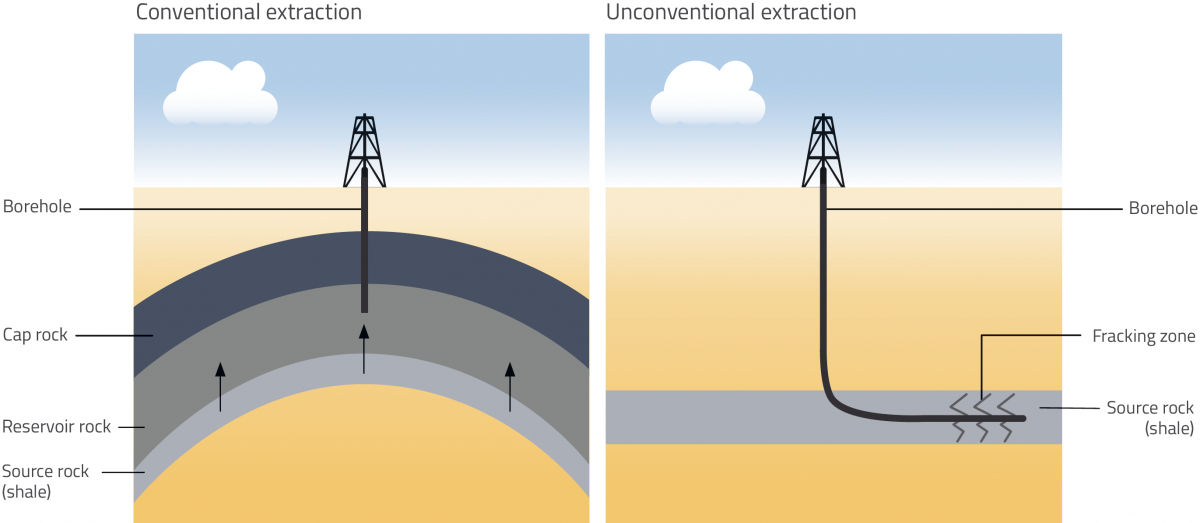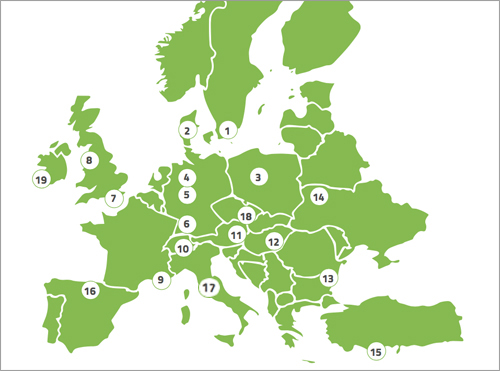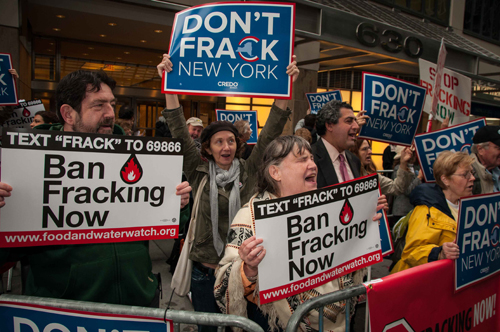Ten things you might not know about fracking Understand article
Fracking is a hugely controversial technology, so it’s worth taking a closer look at the science behind the headlines.
In the USA, fracking is big business. A surge in fracking over the last few years means that it now accounts for more than 50% of all US gas production – but as levels of fracking have risen, so too have public opposition and concern. In Europe, governments and communities are currently weighing up the costs and benefits of fracking, and some governments have already banned it. But what exactly is fracking, and how does it work? Here we explore some of the science behind the current discussions.
1. Fracking means ‘hydraulic fracturing’.
Fracking is an example of unconventional gas extraction. In this process, water (mixed with sand and chemicals) is injected into rocks under very high pressure to fracture them – hence the name hydraulic fracturing, or fracking.
In conventional extraction of natural gas reserves, such as those under the North Sea, the gas migrates upwards from the source rocks where it was formed and collects under an impermeable rock layer, from where it can be pumped out by drilling (see figure 1). Unconventional gas resources are trapped in the source rocks themselves, which have to be broken to release the gas. Sand particles are used to prevent the fractures from closing again, allowing the gas to escape and migrate to the surface.

Nicola Graf
2. Fracking is used to extract shale gas.
Currently, fracking is mainly used to extract the gas found in fine-grained sedimentary rocks called shales. As sediments of sand and mud were converted into rocks over millions of years under high temperature and pressure, the plant and animal remains associated with the sediments were converted into shale gas, which consists predominantly of methane.
Shale deposits are located all over the world, but the shales that contain the most gas formed in marine environments, particularly in slow-moving, poorly oxygenated water such as ancient sea basins. Here, the plants and animals could not decay before they were buried, providing organic material that was later converted into fossil fuel.
There are potential shale gas reserves across Europe, including the Posidonia Shale in Germany (see 4 on the map, figure 2), and the Bowland Shale in the north of England (see 8, figure 2). The Posidonia Shale was formed about 200 million years ago, at the bottom of the ancient Tethys Sea. Fossils of molluscs are common in these rocks, and those of larger animals have also been found here.

Nicola Graf
3. Fracking has been used for decades.
Fracking is not a new method of extraction: it has been used since the 1940s, but mostly in conventional extraction as a way of obtaining any last remaining gas. The type of fracking used to extract shale gas is more challenging, as shales are found at shallower depths closer to groundwater supplies and require greater volumes of fluid injection than conventional reserves.
More recently, engineers have worked out how to drill sideways into shale deposits, thereby fracking more rocks with only one borehole. In the USA, this development has led to a rapid increase in shale gas production over the last decade. In Europe, however, while there are a few test sites, fracking for shale gas is very limited.
4. Fracking needs a lot of water…
Some states in the USA have run dangerously low on drinking water, due to fracking. A single fracking borehole can use as much as 43 000 m3 of water – enough to supply a small town for about a month. Some boreholes use only a tiny percentage of this amount, but in the USA a large percentage of fracking boreholes are in areas prone to drought, such as Texas and California. In addition, fracking uses drinking water taken from reservoirs and groundwater aquifers, which must be disposed of afterwards rather than returned to the water cycle. This puts added strains on local water resources and is causing a lot of concern.
5. …and a lot of sand.
Fracking uses vast amounts of sand – up to 8000 tonnes per borehole. Fracking now accounts for approximately 60% of the sand used industrially in the USA. The sand needed is quite special: it is carefully sorted to select grains with a particular shape and size, and also with a high quartz content to withstand high pressures.
6. Fracking can cause earthquakes.
While fracking can cause earth tremors, these are generally too small to notice. However, there is evidence that the disposal of fracking fluids causes more problems and larger earthquakes than fracking itself. For example, in Oklahoma, USA, which has a large number of disposal sites, there were just a few tremors every year until 2008, increasing to 20 in 2009 and 105 in 2013. The largest tremor had a magnitude of 5.6 on the Richter scale and destroyed several homes.
Scientists at the US Geological Survey have worked out that the strength of these earthquakes depends on the amount of liquid pumped into the rocks. They calculated that injecting a volume of some 10 000 m3 (enough to fill about four Olympic-sized swimming pools) could result in an earthquake with a maximum magnitude of 3.3. However, this is no prediction as to whether an earthquake will occur or not.

Adam Welz/CREDO
7. It takes a lot of pressure to fracture the rocks.
Shale deposits that can yield gas are usually found at depths of between 1000 m and 5000 m. After the borehole has been drilled down to the rocks, it has to be carefully encased with concrete to protect the surrounding environment before fracking can begin. Holes are then made in the borehole casing near the shales, and the fracking fluid is forced through these holes into the rocks under extremely high pressures – some 680 atm (69 million Pa). As a comparison, professional racing bike tyres have pressures of about 10 atm, or 1 million Pa.
8. In Europe, many potential fracking sites are near cities.
In the north of England, the shale gas reserves are beneath the large cities of Manchester and Leeds. In Germany, the Posidonia shale deposits are located near the city of Hanover, which has a population of over half a million. A couple of boreholes would require an area about the size of a football field, including space for drilling rigs, equipment and trucks; somewhere to store and dispose of water and waste; as well as gas storage and cabins for the workers. Setting up these sites and the associated infrastructure, such as transport routes, near or around any bustling European metropolis would not be easy.
9. Beer brewers in Germany are opposed to fracking.
The German beer purity law states that German beer should be brewed using only hops, yeast, malt and water. Pure, clean water is therefore a crucial ingredient of beer brewing, and many breweries in Germany obtain the water they use from their own wells. Any contamination of water supplies with methane or fracking fluids would be a threat to this important industry, and beer brewers in Germany have publicly declared their anti-fracking position.
Fracking advocates argue, however, that there are thick, impermeable layers of rock above shale deposits, which would act as a protective barrier during fracking, protecting shallow groundwater supplies from potential contamination. In addition, fracking must always take place at a defined distance away from groundwater. Another safety factor is that if any fracking fluids were to escape, they would sink downwards, rather than migrating upwards towards the groundwater level. But while groundwater supplies might be protected from any contamination occurring at depth, there have been cases of groundwater contamination caused by spills on the surface, so careful handling of extraction chemicals and waste around the fracking site is also needed.
10. Scientists are using a similar technique to produce geothermal energy.
A method known as enhanced geothermal systems (EGS) exploits naturally occurring fractures in rocks, and uses high-pressure water to create even more fractures deep down, where the rocks are naturally hot. This creates a geothermal reservoir, which heats up water pumped down into the rocks, and the resulting steam is used to generate electricity. Once the water has cooled, it is then pumped back down into the rocks to be heated again.
Unlike in fracking for shale gas, no sand or other chemicals are needed for this process. The process is still controversial, however: an EGS project in Basel, Switzerland, was cancelled after it caused significant tremors, leading to insurance claims totalling millions of euros. But development and research continue: in Europe, there are EGS test facilities in Portugal, France and Germany, and projects are planned in Cornwall, UK that are expected to be operational by around 2020.
Acknowledgement
The author would like to thank Professor Dr Ernst Huenges and Dr Hans-Martin Schulz from the German Research Centre for Geosciences (GFZ), and Dr Clement Uguna from the University of Nottingham, UK, for their helpful input and comments on this article.
Resources
- Read a study about how earthquakes can be induced by fracking. See:
- Ellsworth WL (2013) Injection-induced earthquakes. Science 341(6142): 1225942-1–7 doi: 10.1126/science.1225942
- Information and an interactive map of induced earthquakes can be found on HiQuake, a database of human-induced earthquakes.
- The US Geological Survey recently published a study on water consumption used by fracking. Find out more in this article from Scientific American.
- To learn about the current state of shale gas production in Germany, visit the Shale Gas Information Platform website.
- Information about shale gas geology, resources and production in the UK are available on the British Geological Survey website.
- Learn more about fracking and current public opinion in the UK with this article published by The Guardian.
- Watch a TEDed lesson entitled ‘How does fracking work?’ to learn about the technology behind fracking, and why it is so controversial.
Review
This article provides an interesting way to introduce the topic of fracking into lessons in different subjects. For example, it could be used in earth science to explore the idea of human-induced earthquakes compared to the natural phenomena.
Fracking is also a suitable topic for discussion about citizenship and science communication, including the involvement of citizens in decisions about environmental matters, and the relationships between science, politics, environmental protection and economic interests.
The article could be used as a role-play activity, with different students taking the roles of scientists, politicians, environmental activists and citizens. Students would use and follow up the information in the article to defend their points of view in a debate.
Teresita Gravina, science teacher, Istituto Comprensivo Luigi Vanvitelli, Italy





